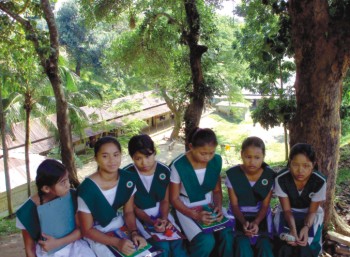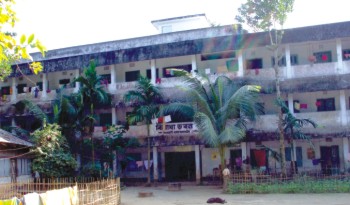| Education
Illuminating the Hills of Chittagong
Located in Rangamati, Moanoghar, the largest residential school
for the ethnic communities is struggling to continue its efforts of
promoting peace and development through education
Tamanna Khan
 |
The classrooms are scattered up and down the hills of the school compound.
Photo: Illora Sharmeen |
Nation Chakma, a student of Rangamati College, comes from a remote hill of Rangamati in the Chittagong Hill Tracts. “It takes about two days to travel from my house to Rangamati town. From the town you first have to take a bus then cross a river by a boat and lastly a four-hour climb up the hills,” says Nation. Having lost his father at an early age, it became almost impossible for him to continue education after the primary level.
“There is no secondary school at our locality and traveling to the town daily from that place is almost impossible. Besides, I did not even have the money to pay my school fees,” he adds.
When Nation, who dreams of becoming a banker some day, was on the verge of dropping out, Moanoghar saved his day. “I took admission at Moanoghar at class-six,” Nation says, “The school was not only free but also provided free accommodation and food. Even after I have joined college they have allowed me to stay at the school hostel so that I can continue my education at Rangamati College from here.” Besides, free food and accommodation, Nation, along with eight of his batch-mates, receives a travel allowance for attending classes in the college in return for tutoring the junior students of the school and helping in maintaining the school facilities.
Like Nation, Moanoghar has brought the light of education to thousands of ethnic children from the three hill districts of Chittagong – Rangamati, Khagrachari and Bandarban. Buddha Datta Vante, joint secretary of Moanoghar's executive committee says, “Those who come to Moanoghar usually live in remote areas of the three hill districts like Thanchi and Ruma, where there are no schools and classes cannot be held during the rainy season. You would find children from almost 10-11 ethnic communities here – Chakma, Marma, Khiyang, Tripura, Khumi, Luchai, Bong, Santal and even Monipuris from the hills of Sylhet.”
 |
Most of the residential students come from the hinterlands of the Chittagong Hill Tracts.
Photos: Illora Sharmeen |
Moanoghar started off in 1974 as an orphanage for children who had lost their parents during the Liberation War of Bangladesh. “There was a Birangana camp at the place where the Rangamati Orphanage now stands. From our temple we could hear the cries of helpless women and children who had been tortured by the military. We were SSC (Secondary School Certificate) examinees at that time – Bimal and Praggananda and I. We began to think that something must be done to help these children,” says Ssraddha Lankar Mahathero, one of the three founders of Moanoghar, which is situated in the Rangapani area of Rangamati. He says that besides the orphans of the War, there was an army of vulnerable children among the ethnic communities of the Chittagong Hill Tracts, whose parents had lost their home and occupation because of the construction of Kaptai Dam and the settlement of Bengalis in the Hill districts.
Consequently, the three young Buddhist monks began to plan the opening of a school for the orphans, war-children and underprivileged children of the hill districts. “The temporary shaft that hill people build in their fields on the hills to store the harvest of vegetables cultivated along with rice is called Moanoghar. They use it for six months and after harvest they go back to their villages with the crops for the next six months. In line with this concept, we named our school Moanoghar, where children will come and cultivate their minds through general as well as technical education and go back to their homes or workplace with the light of knowledge,” Mahathero says.
When they started, the Buddhist monks received donations from the locals in the form of land, musti (alms) and voluntary work but as the number of children grew from the initial 30, it became almost impossible to run the school on alms. Help came from a French humanitarian organisation named Partage in 1982-83 that provided fund to build the necessary infrastructures and acquire more land in Rangapani.
 |
Bishakha Bhaban – the only girl's hostel housing 189 girls from class two to class ten.
Photos: Illora Sharmeen |
Later, when Ministry of Chittagong Hill Tracts Affair was formed after the Peace Accord of 1997, Partage stopped funding as the ministry took over some of the financial responsibilities of the school. However, during the caretaker government regime, the fund was temporarily stopped. With the student population exceeding 1000, fifty percent of who are residential, the school began to face dire financial crisis. “From 2008, we began to take fees from a portion of the students who could afford it. At that time, Rotary Foundation, through the Rotary Club of Karwan Bazaar came with a 3-year-long scholarship programme 'Promotion of Secondary Level Education Among Minorities', sponsoring 50 students from class eight to secondary school level,” Buddha says.
Lily Dewan, one of the three full-time hostel-supers of Bishakha Bhaban, the only girl's hostel that houses 189 girls informs,“Orphans are now admitted only if a sponsor can be found. The imposition of fees is affecting the drop-out rate and admission rate as many cannot even afford the nominal fee of Tk 1800 a year that the school now charges.”
“At present the school receives Tk 1 lac grant from the Social Welfare Ministry but it is not enough to cover even the daily meals of the 500 residential students or the salary of the 80 full time staff of the school,” says Buddha. “The quality of food is very poor and the menu is without variation–rice, lentil and vegetable with perhaps a meat dish once a month,” admits Buddha, who claims that Moanoghar cannot afford to improve the current diet under their present fund. “The 12 boy's hostel and 1 girl's hostel are in dilapidated condition. We cannot even provide bed to all the residential students,” he adds.
Rotarian Ahmed Farooquee, ex-president and project coordinator of the scholarship programme, thinks that providing support to a school like Moanoghar is very important to promote peace and development in the hinterlands of the Chittagong Hill Tracts. “The ethnic communities do not have adequate opportunities to pursue mid-level education. Moanoghar being a residential school can attract different ethnic groups from distant areas,” he says.
Tucked in the lush green hills of Rangamati, Moanoghar has all the possibilities to become a prestigious educational institution with its acres of land, intelligent and committed staff, support of the local community and above all promising students. All it needs is proper funding and a strong professional management to run the facilities and continue its task of kindling the light of knowledge among ethnic tribal communities of Bangladesh.
Copyright
(R) thedailystar.net 2010 |
|
